During a filming trip to Kyrgyzstan, Nayla Tawa experienced a life changing accident that ultimately lead her to complex knee specialist Dr. LaPrade. Nayla’s accident resulted in a PCL tear, superficial MCL tear and deep MCL tear. She was told she would likely never snowboard again. After a double-bundle PCL reconstruction, superficial MCL reconstruction, deep MCL repair and a year of rehabilitation, Nayla is back on her board and headed back to Kyrgyzstan to finish her film.
Snowboarding lead Colorado native Nayla Tawa, a film and geography student, to Kyrgyzstan to make a film on ski tourism
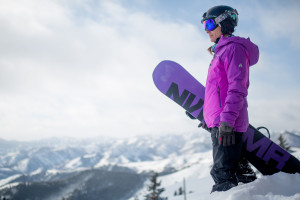
Jon Mancuso Photography
One moment can change everything. For Nayla Tawa February 3, 2012 was a day that forever changed her life.
Growing up in Boulder, Colorado, Nayla is no stranger to outdoor activities. She learned to ski in the Rocky Mountains and later took up snowboarding, which ultimately lead her on her journey to Kyrgyzstan. “One of my close friends was working in the Peace Corps in Kyrgyzstan and invited me on a backcountry snowboarding trip. At the time, I was in school at University of California, Los Angeles studying film and geography,” said Nayla. Nayla’s film teacher overheard her talking about her upcoming trip and told her, “Nayla, you must make a film while you are there.” Always up for a challenge, Nayla thought, “why not?” Her friend told her about a local Kyrgyz man’s vision to better his country’s economy through ski tourism. “After hearing about this local man’s story, I knew I had found my film,” Nayla said.
After extensive planning and fundraising, Nayla’s journey took a tragic turn when her cab had a serious accident on the way to their final destination Karakol, Kyrgyzstan

After months of planning and fundraising in February, 2012 Nayla and her crew began their adventure to Kyrgyzstan. Once in Kyrgyzstan they had to take a six-hour taxi ride to their final destination, Karakol, Kyrgyzstan. Three hours into the ride, the cab slid on ice going 60 mph, sending the car off the road and into trees. “At first, I had a hard time breathing – which I later found out was because I had broken my sternum and bruised my ribs – but, I did not know I was injured past that. I thought I was fine until Adam, a friend who was in the car with me moved to get out – that is when I felt my injuries. I felt my knee and my back,” said Nayla.
“Luckily, I did not have a head injury, so I was able to think straight. My friend Doug, who was in the car with me, was trapped in the front seat and the car was crushing him. I knew I would need help to get him out of the car. I was able to get myself out of the car and onto the cold snow. I crawled on the snowpack and waved a local truck down,” Nayla said.
Nayla spent two days duct-taped to her snowboard – a makeshift backboard – before she and her crew were evacuated to Dubai for treatment
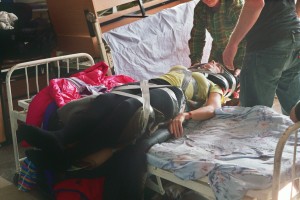
Nayla duct-taped to the backboard
Nayla was first taken to a local ‘hospital’ in Kyrgyzstan, which was ill equipped for traumatic patient care. Fortunately, a member of the filming crew who was not involved in the accident was a paramedic in the United States. Without access to proper rescue equipment, the paramedic created a makeshift backboard by using duct tape to secure Nayla to her snowboard. Nayla spent two days duct-taped to her snowboard before she and her crew were evacuated to Dubai.
While in Dubai, Nayla was given an initial diagnosis, which included a PCL tear in her knee. “Before heading back home to Colorado, one of the physicians at the hospital in Dubai recommended that I see complex knee specialist Robert LaPrade, MD at The Steadman Clinic in Vail, Colorado. He told me that Dr. LaPrade was one of the top surgeons in the world to treat PCL injuries. Little did I know that Dr. LaPrade would ultimately be the surgeon to fix my knee,” said Nayla.
After receiving a spectrum of diagnoses on her PCL tear ranging from amputation to never being able to snowboard again, Nayla sought the advice of Dr. LaPrade
“Ten days after my accident, I was back in Colorado and was given a full diagnosis. I had broken my back in three places, broke my sternum, tore my sternoclavicular (SC) joint, severely bruised my collarbone and ribs and was initially told that I tore all four ligaments (ACL, MCL, PCL and FCL) in my knee. The torn ligaments in the knee were the only injury that ultimately required surgery,” Nayla said.

Prior to meeting Dr. LaPrade, Nayla had received three medical opinions from other physicians. “At the time, PCL injuries were very uncommon and difficult to treat – so the spectrum of diagnoses ranged from amputating my leg to never being able to snowboard again – all of which were solutions I was not willing to settle for,” said Nayla.
Finally, Nayla made an appointment with Dr. LaPrade. She said, “my first meeting with Dr. LaPrade made me instantly appreciate his honesty. He told me that this process was going to be a hard, but he said, ‘If we put in the work together, we can get you back on your snowboard.’ He was the only physician to tell me that.”
Not only was Nayla impressed with Dr. LaPrade’s honesty, but also she was impressed with his knowledge. “Prior to my appointment, I had done a lot of research online about treatment techniques for PCL reconstructions and the risks involved. Through my research I had learned that Dr. LaPrade had a lot of positive patient outcomes for PCL reconstruction, so I came equipped with questions. Dr. LaPrade took the time and answered each question in detail. After that, I felt like I really understood what I was getting into,” said Nayla.
During her physical examination, Dr. LaPrade said the ACL was actually stretched, not torn. All imaging and previous diagnoses showed that the ACL had been torn and Nayla would later find out that Dr. LaPrade was correct. She only had a PCL tear, superficial MCL tear and deep MCL tear.
Nayla and Dr. LaPrade began their work together to get her back on her snowboard
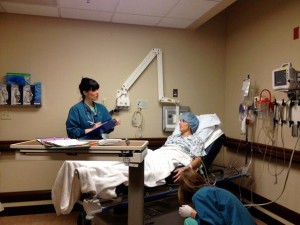
Nayla the morning of surgery
After her diagnosis with Dr. LaPrade, Nayla schedule the surgery for the following week. “The day before surgery, I was having unsettled nerves, but thankfully I was able to connect with a former physician, Dr. Gamradt who told me, ‘you are in the best possible hands for your complex knee injury. Dr. LaPrade is the God of PCL surgery’. And with those words of reassurance, I was ready for the inevitable,” Nayla said.
The morning of surgery Nayla and her father were driving from Silverthorne, Colorado to Vail, Colorado when a severe snowstorm came through. Nayla’s father wanted to reschedule because of the roads, but Nayla was ready, “I wanted to get it over with,” Nayla said. Their car was the last one to make it over Vail pass before I-70 closed. Due to the chaos of the morning, Nayla was again feeling nervous, but as soon as Dr. LaPrade walked in, her nerves calmed.

Nayla says, “Bedazzling my handicap devices – back brace, walker, leg brace – kept my spirits up.”
The surgery took three hours. It consisted of a double bundle PCL reconstruction, a superficial MCL reconstruction with a POL (posterior oblique ligament) and deep MCL repair. Her ACL was, in fact, found to be intact due to the posterior positioning of her knee from the severe PCL tear; it was buckled which made it appear torn on the MRI scan.
Once the surgery was over, the hard part began. “Rehab took over my life,” said Nayla. “For PCL patients, rehab is twice a day, but – with my other injuries – I was at the Howard Head Rehabilitation Center with my physical therapists Thomas Olsen and Eric Dube four times a day.” Due to her SC joint injury, Nayla was unable to use crutches, so she had to use a wheelchair instead. “I am such a ‘go-go’ type of person, one of the hardest parts of the 12 month recovery was learning to slow down and ask for help. I could’t do anything on my own,” said Nayla.
With the three hour surgery completed, her 12 month recovery and rehabilitation began
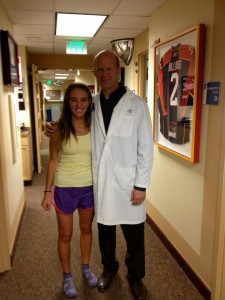
11 months after surgery to correct her MCL & PCL tears, Dr. Laprade graduated Nayla from her jack brace
As time progressed, Nayla slowly began to improve. The frequency of rehab appointments decreased, and she slowly regained her life back. “The biggest milestone for me during rehab was when I was finally free of the Jack brace! I had to wear the brace 24/7 for over eleven months,” said Nayla.
“Overall, I had a really great time in rehab. I learned a lot about myself and about life perspective. I learned that the little things in life don’t matter. Life is really about family and friends,” said Nayla.
“The biggest piece of advice I would give patients is to stay positive! Everyone has his or her own way of staying positive, so do whatever it may take for you to stay positive. I believe it helps you recover more quickly. I would also recommend for patients to research their doctor before moving forward with any treatment, because having 100% confidence in your doctor is the key to a successful recovery,” said Nayla.
Nayla is now back on her snowboard, ready to finish what she started nearly four years ago!
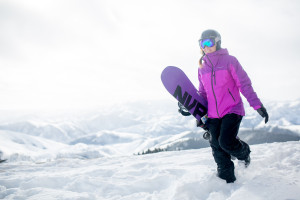
Jon Mancuso Photography
She is finally going back to Kyrgyzstan in February, 2016 to finish her documentary. Nayla said, “My journey has become a part of the documentary, and I know that without Dr. LaPrade and his team, this would not have been possible. I am thankful each day for everything that he has done for me.”
Learn more about Nayla’s project: Return to Kyrgyzstan
